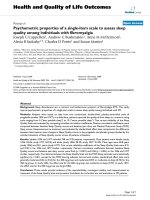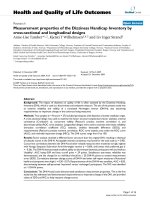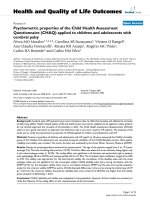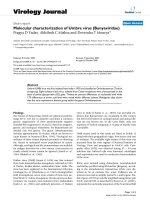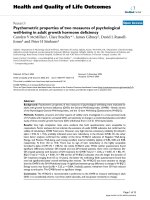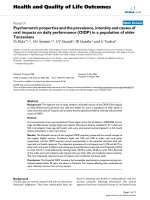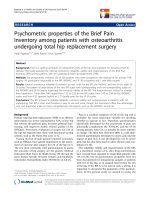Báo cáo hóa học: " Symmetry Properties of Single-Walled BC2N Nanotubes" pdf
Bạn đang xem bản rút gọn của tài liệu. Xem và tải ngay bản đầy đủ của tài liệu tại đây (311.69 KB, 5 trang )
NANO EXPRESS
Symmetry Properties of Single-Walled BC
2
N Nanotubes
Hui Pan Æ Yuan Ping Feng Æ Jianyi Lin
Received: 30 September 2008 / Accepted: 6 February 2009 / Published online: 24 February 2009
Ó to the authors 2009
Abstract The symmetry properties of the single-walled
BC
2
N nanotubes were investigated. All the BC
2
N nano-
tubes possess nonsymmorphic line groups. In contrast with
the carbon and boron nitride nanotubes, armchair and
zigzag BC
2
N nanotubes belong to different line groups,
depending on the index n (even or odd) and the vector
chosen. The number of Raman- active phonon modes is
almost twice that of the infrared-active phonon modes for
all kinds of BC
2
N nanotubes.
Keywords BC
2
N nanotubes Á Symmetry Á Group theory
Introduction
Carbon nanotubes have been extensively studied because
of their interesting physical properties and potential
applications. Motivated by this success, scientists have
been exploring nanotubes and nanostructures made of
different materials. In particular, boron carbon nitride
(B
x
C
y
N
z
) nanotubes have been synthesized [1, 2]. Theo-
retical studies have also been carried out to investigate
the electronic, optical and elastic properties of BC
2
N
nanotubes using the first-principles and tight-binding
methods, respectively [3–6].
Besides the elastic and electronic properties, theoretical
and experimental research on phonon properties of BC
2
N
nanotubes is also useful in understanding the properties of
the nanotubes. For example, the electron–phonon interac-
tion is expected to play crucial roles in normal and
superconducting transition. Furthermore, symmetry prop-
erties of nanotubes have profound implications on their
physical properties, such as photogalvanic effects in boron
nitride nanotubes [7]. Studies on the symmetry properties
of carbon nanotubes predicted the Raman- and infrared-
active vibrations in the single-walled carbon nanotubes [8],
which are consistent with the experimental data [9] and
theoretical calculations [10]. A similar work was carried
out by Alon on boron nitride nanotubes [11], and the results
were later confirmed by first-principles calculations [12].
And the symmetry of BC
2
N nanotube was reported [13].
The purpose of this study is to extend the symmetry
analysis to BC
2
N nanotubes and to determine their line
groups. The vibrational spectra of BC
2
N nanotubes are
predicted based on the symmetry. The number of Raman-
and infrared (IR)-active vibrations of the BC
2
N nanotubes
is determined accordingly.
Structures of BC
2
N Nanotubes
Similar to carbon or boron nitride nanotubes [14, 15], a
single-walled BC
2
N nanotube can be completely specified
by the chiral vector which is given in terms of a pair of
integers (n, m)[3]. However, compared to a carbon and
boron nitride nanotubes, different BC
2
N nanotubes can be
obtained by rolling up a BC
2
N sheet along different
directions, as shown in Fig. 1a, because of the anisotropic
H. Pan Á Y. P. Feng
Department of Physics, National University of Singapore,
2 Science Drive 2, 117542 Singapore, Singapore
H. Pan (&)
Environmental Science Division, Oak Ridge National
Laboratory, 37831 Oak Ridge, TN, USA
e-mail:
J. Lin
Institute of Chemical and Engineering Sciences, 1 Pesek Road,
627833 Jurong Island, Singapore
123
Nanoscale Res Lett (2009) 4:498–502
DOI 10.1007/s11671-009-9272-3
geometry of the BC
2
N sheet. If we follow the notations for
carbon nanotubes [14], at least two types of zigzag BC
2
N
nanotubes and two types of armchair nanotubes can be
obtained [6]. For convenience, we refer the two zigzag
nanotubes obtained by rolling up the BC
2
N sheet along the
a
1
and the a
2
directions as ZZ-1 and ZZ-2, respectively, and
two armchair nanotubes obtained by rolling up the BC
2
N
sheet along the R
1
and R
2
directions as AC-1 and AC-2,
respectively. The corresponding transactional lattice vec-
tors along the tube axes are T
a1
,T
a2
,T
R1
, and T
R2
,
respectively, as shown in Fig. 1a. It is noted that T
a2
is
parallel to R
2
,T
R1
to b
1
, and T
R2
to a
2
. An example of each
type of BC
2
N nanotubes is given in Fig. 1b–f.
Symmetry of BC
2
N Nanotubes
We first consider the achiral carbon nanotubes with the
rotation axis of order n, i.e., zigzag (n, 0) or armchair (n, n).
The nonsymmorphic line-group [16] describing such
achiral carbon nanotubes can be decomposed in the fol-
lowing way [17]:
Gn½¼L
T
z
 D
nh
 E È S
2n
½¼L
T
z
 D
nd
 E È S
2n
½
ð1Þ
where L
T
z
is the 1D translation group with the primitive
translation T
z
= |T
z
|, and E is the identity operation. The
screw axis S
2n
¼ z ! z þT
z
=2; u ! u þp=nðÞinvolves
the smallest nonprimitive translation and rotation [11].
The corresponding BC
2
N sheet of the zigzag (n,0)
BC
2
N nanotubes (ZZ-1) (Fig. 1b) is shown in Fig. 2. They
have vertical symmetry planes as indicated by g. In this
case, the D
nh
and D
nd
point groups reduce to C
nv
due to the
lack of horizontal symmetry axis/plane, and S
2n
vanishes
for the lack of the screw axis. Thus,
G
zzÀ1
n½¼L
T
z
 C
nv
 E ð2Þ
The point group of the line group is readily obtained from
Eq. 2,
G
zzÀ1
0
n½¼C
nv
: ð3Þ
To determine the symmetries at the C point of the 12 N (N
is the number of unit cells in the tube and N = n for ZZ-1
BC
2
N nanotubes) of phonons in ZZ-1 BC
2
N nanotubes and
the number of Raman- or IR-active modes, we have to
associate them with the irreducible representations (irrep’s)
of C
nv
. Here, two cases need to be considered.
Case 1
n is odd (or n = 2m ? 1, m is an integer)
The character table of C
(2m?1)v
possesses m ? 2 irrep’s
[18], i.e.,
C
C
ð2mþ1Þv
¼ A
1
È A
2
È
X
m
j¼1
E
j
ð4Þ
The 12 N phonon modes transform according to the
following irrep’s:
Fig. 1 Atomic configuration of an isolated BC
2
N sheet. Primitive
and translational vectors are indicated
Fig. 2 2D projections of zigzag BC2N nanotubes (ZZ-1). z is a glide
plane
Nanoscale Res Lett (2009) 4:498–502 499
123
C
ZZÀ1
12N
¼ C
ZZÀ1
o
C
v
¼ 8A
1
È 4A
2
È
X
m
j¼1
12E
j
ð5Þ
where
C
ZZÀ1
o
¼ 4A
1
È
X
m
j¼1
4E
j
N ¼ nðÞ ð6Þ
stands for the reducible representation of the atom
positions inside the unit cell. The prefactor of 4 in C
ZZÀ1
o
reflects the four equivalent and disjoint sublattices made by
the four atoms in the ZZ-1 BC
2
N nanotubes. C
v
¼ A
1
È E
1
is the vector representation. Of these modes, the ones that
transform according to C
t
¼ A
1
È E
1
È E
2
(the tensor
representation) or C
v
are Raman- or IR-active,
respectively. Out of the 12 N modes, four have vanishing
frequencies [19], which transform as C
v
and C
R
z
¼ A
2
corresponding to the three translational degrees of freedom
giving rise to null vibrations of zero frequencies, and one
rotational degree about the tube’s own axis, respectively.
C
ZZÀ1
Raman
¼ 7A
1
È 11E
1
È 12E
2
) n
ZZÀ1
Rman
¼ 30 ð7Þ
C
ZZÀ1
IR
¼ 7A
1
È 11E
1
) n
ZZÀ1
Ir
¼ 18 ð8Þ
Case 2
n is even (or n = 2m, m is an integer)
The character table of C
2mv
possesses m ? 3 irrep’s
[18], i.e.,
C
C
ð2mþ1Þv
¼ A
1
È A
2
È B
1
È B
2
È
X
mÀ1
j¼1
E
j
ð9Þ
The 12 N phonon modes transform according to the
following irrep’s:
C
ZZÀ1
12N
¼ C
ZZÀ1
e
C
v
¼ 8A
1
È 4A
2
È 8B
1
È 4B
2
È
X
mÀ1
j¼1
12E
j
ð10Þ
where
C
ZZÀ1
e
¼ 4A
1
È 4B
1
È
X
mÀ1
j¼1
4E
j
N ¼ nðÞ ð11Þ
C
v
¼ A
1
È E
1
is the vector representation. Of these modes,
the ones that transform according to C
t
¼ A
1
È E
1
È E
2
(the tensor representation) or C
v
are Raman- or IR-active,
respectively. Out of the 12 N modes, four (which transform
as C
v
and C
R
z
¼ A
2
) have vanishing frequencies [16].
C
ZZÀ1
Raman
¼ 7A
1
È 11E
1
È 12E
2
) n
ZZÀ1
Rman
¼ 30 ð12Þ
C
ZZÀ1
IR
¼ 7A
1
È 11E
1
) n
ZZÀ1
Ir
¼ 18 ð13Þ
The numbers of Raman- and IR- active modes are 30 and
18, respectively, for ZZ-1 BC
2
N nanotubes irrespective n.
The armchair (n, n)BC
2
N nanotubes (AC-1) (Fig. 1d),
corresponding to the BC
2
N sheet shown in Fig. 3, have
horizontal planes as indicated by g. The D
nh
and D
nd
point
groups reduce to C
nh
owing to the lack of C
2
axes and S
2n
vanishes for the lack of the screw axis.
G
zzÀ1
n½¼L
T
z
 C
nh
 E ð14Þ
The point group of the line group is readily obtained from
Eq. 2,
G
zzÀ1
0
n½¼C
nh
ð15Þ
To determine the symmetries (at the C point) of the 12 N
(N = n) phonons in AC-1 BC
2
N nanotubes and the number
of Raman- or IR-active modes, two cases need consider-
ation, by associating them with the irrep’s of C
nh
.
Case 1
n is odd (n = 2m? 1)
The character table of C
(2m?1)h
possesses 4m ? 2 irrep’s
[18], i.e.,
C
C
ð2mþ1Þv
¼ A
0
È A
00
È
X
m
j¼1
E
0
Æ
j
È E
00
Æ
j
no
ð16Þ
The 12 N phonon modes transform according to the
following irrep’s:
C
ACÀ2
12N
¼C
ACÀ2
o
C
v
¼8A
0
È4A
00
È
X
m
j¼1
4E
0
j
È8E
00
j
no
ð17Þ
where
C
ACÀ2
o
¼ 4A
0
È
X
m
j¼1;3;5;
4E
0
Æ
j
È
X
m
j¼2;4;6;
4E
00
Æ
j
N ¼nðÞð18Þ
Fig. 3 2D projections of armchair BC2N nanotubes (AC-1). z is a
glide plane
500 Nanoscale Res Lett (2009) 4:498–502
123
and C
v
¼ A
00
ÈE
0
Æ
1
is the vector representation. Of these
modes, the ones that transform according to C
t
¼ A
0
ÈE
0
Æ
2
È
E
00
Æ
1
(the tensor representation) or C
v
are Raman- or IR-active,
respectively. Out of the 12 N modes, four (which transform
as C
v
and C
R
z
¼ A
0
) have vanishing frequencies [19].
C
ACÀ2
Raman
¼ 7A
0
È 4E
0
Æ
2
È 8E
00
Æ
1
) n
ACÀ2
Rman
¼ 19 ð19Þ
C
ACÀ2
IR
¼ 7A
0
È 3E
0
Æ
1
) n
ZZÀ1
Ir
¼ 10 ð20Þ
Case 2
n is even(n = 2m)
The character table of C
2mh
possesses 4m irrep’s [18], i.e.,
C
C
2mv
¼ A
g
È B
g
È A
u
È B
u
È
X
mÀ1
j¼1
E
Æ
jg
È E
Æ
jg
no
ð21Þ
The 12 N phonon modes transform according to the
following irrep’s:
C
ACÀ2
12N
¼ C
ACÀ2
e
C
v
¼ 8A
g
È 4B
g
È 4A
u
È 8B
u
È 4E
Æ
1g
È 8E
Æ
2g
È 4E
Æ
3g
ÈÁÁÁÈ 6 þ2 À1ðÞ
mÀ1
E
Æ
mÀ1ðÞg
hi
È 8E
Æ
1u
È 4E
Æ
2u
È 8E
Æ
3u
ÈÁÁÁÈ 6 þ2 À1ðÞ
m
½E
Æ
mÀ1ðÞu
ð22Þ
where
C
ACÀ2
e
¼ 4A
g
È 4B
u
È
X
mÀ1
j¼2;4;6;
4E
Æ
jg
È
X
mÀ1
j¼1;3;5;
4E
Æ
ju
N ¼ nðÞ
ð23Þ
C
v
¼ A
u
È E
Æ
1u
is the vector representation. Of these modes,
the ones that transform according to C
t
¼ A
g
È E
Æ
1g
È E
Æ
2g
(the tensor representation) or C
v
are Raman- or IR-active,
respectively. Out of the 12 N modes, four (which transform
as C
v
and C
R
z
¼ A
g
) have vanishing frequencies [19].
C
ACÀ2
Raman
¼ 7A
g
È 4E
Æ
1g
È 8E
Æ
2g
) n
ACÀ2
Rman
¼ 19 ð24Þ
C
ACÀ2
IR
¼ 3A
u
È 7E
Æ
1u
) n
ZZÀ1
Ir
¼ 10 ð25Þ
The numbers of Raman- and IR- active modes are 19 and
10, respectively, for AC-1 BC
2
N nanotubes in irrespective
of n. The numbers of Raman- and IR- active phonon modes
for ZZ-1 BC
2
N nanotubes are almost twice as for AC-1
BC
2
N nanotubes, which is similar to boron nitride nano-
tubes [11].
The nonsymmorphic line group describing the (n
0
; m
0
)-
chiral carbon nanotubes can be decomposed as follows:
GN½¼L
T
z
 D
d
Â
X
N=dÀ1
j¼0
S
j
N=d
"#
¼ L
t
z
 D
1
Â
X
NÀ1
j¼0
S
j
N
"#
ð26Þ
where N ¼ 2 n
0
2
þ m
0
2
þ n
0
m
0
ÀÁ
=d
R
; where d
R
is the
greatest common divisor of 2n
0
þ m
0
and 2m
0
þ n
0
; d is
the greatest common divisor of n
0
and m
0
;S
N/d
and S
N
are
the screw-axis operations with the orders of N/d and N,
respectively. The point group of the line group is obtained
from Eq. 26,
G
0
½N¼
X
N=dÀ1
j¼0
C
j
N=d
 D
d
¼
X
NÀ1
j¼0
C
j
N
 D
1
¼ D
N
ð27Þ
where C
N=d
¼ / ! / þ 2dp=NðÞand C
N
¼ / ! /þð
2p=NÞ are the rotations embedded in S
N/d
and S
N
,
respectively.
For chiral (n, m)BC
2
N nanotubes, the point group D
N
reduces to C
N
due for the lack of C
2
axes. Here,
N ¼ n
0
2
þ m
0
2
þ n
0
m
0
ÀÁ
=d
R
n
0
¼ 2n; m
0
¼ m
ÀÁ
, where d
R
is
the greatest common divisor of 2n
0
þ m
0
and 2m
0
þ n
0
; d is
the greatest common divisor of n
0
and m
0
. The BC
2
N sheets
corresponding to ZZ-2 and AC-2 are shown in Fig. 4a and
b, which are chiral in nature. The r
v
and r
h
vanish in
Fig. 4a and b, respectively, for ZZ-2 and AC-2 BC
2
N
nanotubes, N = 4n. The point group corresponding to the
two models is expressed as:
G
0
½N¼
X
N=dÀ1
j¼0
C
j
N=d
 C
d
¼
X
NÀ1
j¼0
C
j
N
 C
1
¼ C
N
ð28Þ
The character table of C
N
has N irrep’s, i.e.,
C
ch
C
N
¼ A È B È
X
N=2À1
j¼1
E
Æ
j
ð29Þ
The 12 N phonon modes transform according to the
following irrep’s:
C
ch
12N
¼ C
ch
a
C
v
¼ 12A È12B È
X
N=2À1
j¼1
12E
Æ
j
ð30Þ
where C
ch
a
¼ 4 A ÈB È
P
N=2À1
j¼1
E
Æ
j
!
and C
v
¼ A È E
Æ
1
.Of
these modes, the ones that transform according to C
t
¼
A ÈE
Æ
1
È E
Æ
2
and/or C
v
are Raman- and/or IR- active,
respectively. Out of the 24 N modes, four (which transform
as C
v
and C
R
z
¼ A) have vanishing frequencies [19].
C
ch
Raman
¼ 10A È11E
Æ
1
È 12E
Æ
2
) n
ch
Rman
¼ 33 ð31Þ
C
ch
IR
¼ 10A È11E
Æ
1
) n
ZZÀ1
Ir
¼ 21 ð32Þ
Experimentally, only several Raman/IR-active modes can
be observed. The observable Raman-active modes are with
the range of 0–2000 cm
-1
. The E
2g
mode around
1580 cm
-1
is related to the stretching mode of C–C bond.
The E
2g
mode around 1370 cm
-1
is attributed to B–N
vibrational mode [20, 21]. The experimental Raman
Nanoscale Res Lett (2009) 4:498–502 501
123
spectra between 100 and 300 cm
-1
should be attributed to
E
1g
and A
1g
modes [22].
Conclusions
In summary, the symmetry properties of BC
2
N nanotubes
were discussed based on line group. All BC
2
N nanotubes
possess nonsymmorphic line groups, just like carbon
nanotubes [8] and boron nitride nanotubes [11]. Contrary to
carbon and boron nitride nanotubes, armchair and zigzag
BC
2
N nanotubes belong to different line groups, depending
on the index n (even or odd) and the vector chosen. By
utilizing the symmetries of the factor groups of the line
groups, it was found that all ZZ-1 BC
2
N nanotubes have 30
Raman- and 18 IR- active phonon modes; all AC-1 BC
2
N
nanotubes have 19 Raman- and 10 IR-active phonon
modes; all ZZ-2, AC-2, and other chiral BC
2
N nanotubes
have 33 Raman- and 21 IR-active phonon modes. It is
noticed that the numbers of Raman- and IR- active phonon
modes in ZZ-1 BC
2
N nanotubes are almost twice as in AC-
1BC
2
N nanotubes, but which is almost the same as those
in chiral, ZZ-2, and AC-2 BC
2
N nanotubes. The situation in
BC
2
N nanotubes is different from that in carbon or boron
nitride nanotubes [8, 11].
References
1. Z. Weng-Sieh, K. Cherrey, N.G. Chopra, X. Blase, Y. Miyamoto,
A. Rubio, M.L. Cohen, S.G. Louie, A. Zettl, R. Gronsky, Phys.
Rev. B 51, 11–229 (1995)
2. K. Suenaga, C. Colliex, N. Demoncy, A. Loiseau, H. Pascard, F.
Willaime, Science 278, 653 (1997). doi:10.1126/science.278.
5338.653
3. Y. Miyamoto, A. Rubio, M.L. Cohen, S.G. Louie, Phys. Rev. B
50, 4976 (1994). doi:10.1103/PhysRevB.50.4976
4. E. Herna
´
ndez, C. Goze, P. Bernier, A. Rubio, Phys. Rev. Lett. 80,
4502 (1998). doi:10.1103/PhysRevLett.80.4502
5. H. Pan, Y.P. Feng, J.Y. Lin, Phys. Rev. B 74, 045409 (2006).
doi:10.1103/PhysRevB.74.045409
6. H. Pan, Y.P. Feng, J.Y. Lin, Phys. Rev. B 73, 035420 (2006).
doi:10.1103/PhysRevB.73.035420
7. P. Kral, E.J. Mele, D. Tomanek, Phys. Rev. Lett. 85, 1512 (2000).
doi:10.1103/PhysRevLett.85.1512
8. O.E. Alon, Phys. Rev. B 63, 201403(R) (2001)
9. A.M. Rao, E. Richter, S. Bandow, B. Chase, P.C. Eklund, K.A.
Williams, S. Fang, K.R. Subbaswamy, M. Menon, A. Thess, R.E.
Smalley, G. Dresselhaus, M.S. Dresselhaus, Science 275, 187
(1997). doi:10.1126/science.275.5297.187
10. L.H. Ye, B.G. Liu, D.S. Wang, R. Han, Phys. Rev. B 69, 235409
(2004). doi:10.1103/PhysRevB.69.235409
11. O.E. Alon, Phys. Rev. B 64, 153408 (2001). doi:10.1103/
PhysRevB.64.153408
12. L. Wirtz, A. Rubio, R.A. delaConcha, A. Loiseau, Phys. Rev. B
68, 045425 (2003). doi:10.1103/PhysRevB.68.045425
13. M. Damnjanovic, T. Vukovic, I. Milosevic, B. Nikolic, Acta
Crystallogr. A 57, 304 (2001). doi:10.1107/S0108767300018857
14. M.S. Dresselhaus, G. Dresslhaus, P.C. Eklund, Science of Ful-
lerenes and Carbon Nanotubes (Acadamic Press, San Diego,
1996), p. 804
15. A. Rubio, J.L. Corkill, M.L. Cohen, Phys. Rev. B 49, 5081
(1994). doi:10.1103/PhysRevB.49.5081
16. M. Damnjanovic, I. Milosevic, T. Vukovic, R. Sredanovic, Phys.
Rev. B 60, 2728 (1999). doi:10.1103/PhysRevB.60.2728
17. M. Damnjanovic, M. Vujicic, Phys. Rev. B 25, 6987 (1982).
doi:10.1103/PhysRevB.25.6987
18. D.C. Harris, M.D. Bertolucci, Symmetry and Spectroscopy: An
Introduction to Vibrational and Electronic Spectroscopy (Dover,
New York, 1989)
19. C.Y. Liang, S. Krimm, J. Chem. Phys. 25, 543 (1956).
doi:10.1063/1.1742962
20. J. Wu, W. Han, W. Walukiewicz, J.W. Ager III, W. Shan, E.E.
Haller, A. Zettl, Nano Lett. 4, 647 (2004)
21. C.Y. Zhi, X.D. Bai, E.G. Wang, Appl. Phys. Lett.
80, 3590
(2002). doi:10.1063/1.1479207
22. R. Saito, T. Takeya, T. Kimura, G. Dresselhaus, M.S. Dressel-
haus, Phys. Rev. B 57, 4145 (1998). doi:10.1103/PhysRevB.
57.4145
Fig. 4 2D projections of BC2N
nanotubes a ZZ-2 and b AC-2. z
is a glide plane
502 Nanoscale Res Lett (2009) 4:498–502
123
